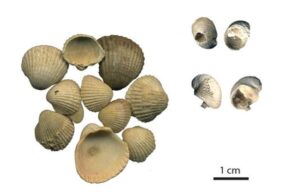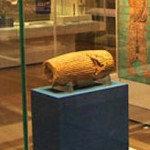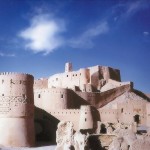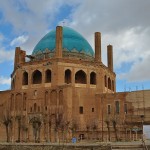According to a statement released by De Gruyter, an analysis of shell beads found at the Kaylu rock shelter, which is located on the eastern shores of the Caspian Sea, suggests that people may have taken maritime voyages some 11,500 years ago. Archaeological evidences shows that the rock shelter was in use for long periods of time during the late Mesolithic and Neolithic periods. Solange Rigaud of CNRS and the University of Bordeaux and her colleagues determined that the beads produced by the last of the hunter-gatherers to inhabit the rock shelter were different from those used by the first farmers. Rigaud and her team also compared the Kaylu rock shelter beads with others found in other Caspian Sea regions. Their analysis suggests there may have been a route for the exchange of these beads along the northern coastline of the Caspian Sea that was independent of the land route known to have been traveled by farmers and herders across northern Iran. These people could have also traveled by boat, she added. “Seafaring contacts between these communities may have granted the rapid circulation of specific bead-types—along with people, information, knowledge and symbols—from either side of the Caspian Sea by long maritime voyages,” Rigaud concluded. Read the original scholarly article about this research in Open Archaeology.
Single-Celled Parasites Identified in Jerusalem’s Ancient Toilets
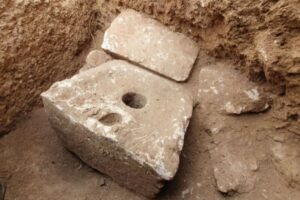 According to a statement released by the University of Cambridge, traces of the single-cell parasite Giardia duodenalis have been detected in the soils associated with two 2,600-year-old toilets made up of stone seats situated over cesspits that were found at what were the homes of wealthy people in Jerusalem. Giardia can cause diarrhea, cramps, fever, and death. Initial microscopic examination of the soil taken from the toilets identified the presence of roundworm and other possible intestinal parasites. Piers Mitchell of the University of Cambridge and his colleagues continued the search for evidence of parasites in the ancient feces through the use of a biomolecular technique called “ELISA,” which uses antibodies to detect the presence of single-celled organisms. “Unlike the eggs of other intestinal parasites, the protozoa that cause dysentery are fragile and extremely hard to detect in ancient samples through microscopes without using antibodies,” explained team member Tianyi Wang. Because Giardia spreads via contaminated water and sometimes by flies, Mitchell concluded that it was probably widespread throughout the ancient city. Read the original scholarly article about this research in Parasitology.
According to a statement released by the University of Cambridge, traces of the single-cell parasite Giardia duodenalis have been detected in the soils associated with two 2,600-year-old toilets made up of stone seats situated over cesspits that were found at what were the homes of wealthy people in Jerusalem. Giardia can cause diarrhea, cramps, fever, and death. Initial microscopic examination of the soil taken from the toilets identified the presence of roundworm and other possible intestinal parasites. Piers Mitchell of the University of Cambridge and his colleagues continued the search for evidence of parasites in the ancient feces through the use of a biomolecular technique called “ELISA,” which uses antibodies to detect the presence of single-celled organisms. “Unlike the eggs of other intestinal parasites, the protozoa that cause dysentery are fragile and extremely hard to detect in ancient samples through microscopes without using antibodies,” explained team member Tianyi Wang. Because Giardia spreads via contaminated water and sometimes by flies, Mitchell concluded that it was probably widespread throughout the ancient city. Read the original scholarly article about this research in Parasitology.
Roman Perfume Found in Spain Analyzed
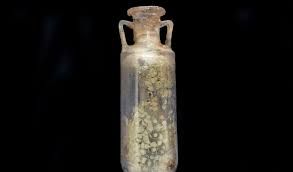 Spain Unguentarium (Cosano et al. 2023, Heritage)CÓRDOBA, SPAIN—According to a statement released by the University of Córdoba, a team of researchers led by chemist José Rafael Ruiz Arrebola has analyzed the contents of a 2,000-year-old vessel recovered from a mausoleum in southern Spain’s Roman city of Carmo. The mausoleum held the remains of six individuals in six urns, one of which was made of glass. The remains of a woman who died between 30 and 40 years of age were found in this glass urn, along with traces of a cloth bag that held a rock crystal flask sealed with a stone and bitumen and three amber beads. The well-preserved material inside the flask was examined with X-ray diffraction, gas chromatography, and mass spectrometry. The study determined that the ointment base had been made from a vegetable oil, perhaps olive oil, while the scent was derived from Pogostemon cablin, a plant from India used to produce the scent patchouli. The high quality of the flask holding the scent suggests that it was a valuable product. Read the original scholarly article about this research in Heritage. For more on Roman Spain, go to “Making an Entrance.”
Spain Unguentarium (Cosano et al. 2023, Heritage)CÓRDOBA, SPAIN—According to a statement released by the University of Córdoba, a team of researchers led by chemist José Rafael Ruiz Arrebola has analyzed the contents of a 2,000-year-old vessel recovered from a mausoleum in southern Spain’s Roman city of Carmo. The mausoleum held the remains of six individuals in six urns, one of which was made of glass. The remains of a woman who died between 30 and 40 years of age were found in this glass urn, along with traces of a cloth bag that held a rock crystal flask sealed with a stone and bitumen and three amber beads. The well-preserved material inside the flask was examined with X-ray diffraction, gas chromatography, and mass spectrometry. The study determined that the ointment base had been made from a vegetable oil, perhaps olive oil, while the scent was derived from Pogostemon cablin, a plant from India used to produce the scent patchouli. The high quality of the flask holding the scent suggests that it was a valuable product. Read the original scholarly article about this research in Heritage. For more on Roman Spain, go to “Making an Entrance.”
International Day of Plant Health
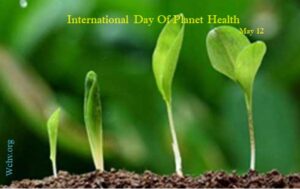 Plants are life – we depend on them for 80 percent of the food we eat and 98 percent of the oxygen we breathe. But international travel and trade has been associated with the introduction and spread of plant pests. Invasive pest species are one of the main drivers of biodiversity loss and threaten the delicate web of life that sustains our planet. Pests and diseases have also been associated with rising temperatures which create new niches for pests to populate and spread. In response, the use of pesticides could increase, which harms pollinators, natural pest enemies and organisms crucial for a healthy environment. Protecting plant health is essential by promoting environmentally friendly practices such as integrated pest management. International standards for phytosanitary measures (ISPMs) in trade also help prevent the introduction and spread of plant pests across borders.
Plants are life – we depend on them for 80 percent of the food we eat and 98 percent of the oxygen we breathe. But international travel and trade has been associated with the introduction and spread of plant pests. Invasive pest species are one of the main drivers of biodiversity loss and threaten the delicate web of life that sustains our planet. Pests and diseases have also been associated with rising temperatures which create new niches for pests to populate and spread. In response, the use of pesticides could increase, which harms pollinators, natural pest enemies and organisms crucial for a healthy environment. Protecting plant health is essential by promoting environmentally friendly practices such as integrated pest management. International standards for phytosanitary measures (ISPMs) in trade also help prevent the introduction and spread of plant pests across borders.
The International Day of Plant Health 2023 calls on everyone to raise awareness and take action to keep our plants healthy and help protect the environment and biodiversity.
U.S. Repatriates Looted Artifacts to Yemen
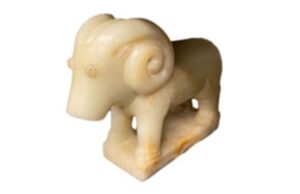 NEW YORK, NEW YORK—According to a statement released by the Manhattan District Attorney’s Office, three artifacts recovered from a private collector were repatriated to Yemen during a recent ceremony attended by Mohammed Al-Hadhrami, the Yemeni ambassador to the United States, and Assistant Special Agent in Charge, James Deboer, of U.S. Homeland Security Investigations. The objects include an alabaster ram with an inscribed base from the Hayd bin Aqeel necropolis that has been dated to the fifth century B.C.; an alabaster figure of a female deity dated to the second century B.C.; and an inscribed silver vessel from Shabwa dated to the second or third centuries A.D. These antiquities were among 89 objects looted from 10 different countries that were seized during a recent investigation. Because of continuing conditions of war in Yemen, the artifacts will be temporarily held at the Smithsonian Institution in Washington, D.C. To read about three carved ram’s heads found along the Avenue of the Sphinxes, go to “Around the World: Egypt.”
NEW YORK, NEW YORK—According to a statement released by the Manhattan District Attorney’s Office, three artifacts recovered from a private collector were repatriated to Yemen during a recent ceremony attended by Mohammed Al-Hadhrami, the Yemeni ambassador to the United States, and Assistant Special Agent in Charge, James Deboer, of U.S. Homeland Security Investigations. The objects include an alabaster ram with an inscribed base from the Hayd bin Aqeel necropolis that has been dated to the fifth century B.C.; an alabaster figure of a female deity dated to the second century B.C.; and an inscribed silver vessel from Shabwa dated to the second or third centuries A.D. These antiquities were among 89 objects looted from 10 different countries that were seized during a recent investigation. Because of continuing conditions of war in Yemen, the artifacts will be temporarily held at the Smithsonian Institution in Washington, D.C. To read about three carved ram’s heads found along the Avenue of the Sphinxes, go to “Around the World: Egypt.”
7,000-Year-Old Tomb Excavated in Oman
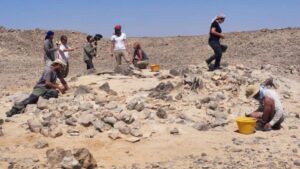 AL WUSTA, OMAN—Live Science reports that the remains of dozens of people have been found in a unique tomb in central Oman by a team of researchers led by Alžběta Danielisová of the Czech Republic’s Institute of Archaeology in Prague. Constructed with walls and a roof made of rows of thin stone slabs called ashlars, the tomb had been covered with a mound of earth. Inside, it was divided into two circular burial chambers that had been further separated into individual compartments. The dead are thought to have decomposed elsewhere, because bones inside these burial chambers were placed in clusters, while the skulls were found near the outside wall, and the long bones had been arranged so that they pointed toward the center of the chamber. The remains are thought to have been deposited in the tomb over a period of several hundred years, beginning about 7,000 years ago. A smaller, similar tomb was found nearby. Analysis of the bones could reveal what the deceased ate and where they were born. Further research in the area could also determine where these people lived.
AL WUSTA, OMAN—Live Science reports that the remains of dozens of people have been found in a unique tomb in central Oman by a team of researchers led by Alžběta Danielisová of the Czech Republic’s Institute of Archaeology in Prague. Constructed with walls and a roof made of rows of thin stone slabs called ashlars, the tomb had been covered with a mound of earth. Inside, it was divided into two circular burial chambers that had been further separated into individual compartments. The dead are thought to have decomposed elsewhere, because bones inside these burial chambers were placed in clusters, while the skulls were found near the outside wall, and the long bones had been arranged so that they pointed toward the center of the chamber. The remains are thought to have been deposited in the tomb over a period of several hundred years, beginning about 7,000 years ago. A smaller, similar tomb was found nearby. Analysis of the bones could reveal what the deceased ate and where they were born. Further research in the area could also determine where these people lived.
Subsurface Imaging Reveals Australia’s Ancient Landscape
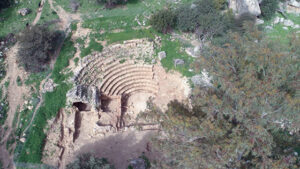 ADELAIDE, AUSTRALIA—According to a statement released by Flinders University, a new survey of the Red Lily Lagoon area in Northern Australia’s West Arnhem Land with electric resistivity tomography (ERT) has revealed that some 8,000 years ago, the ocean’s coastline stretched across what is now an inland region. The area is known for Madjedbebe, a 60,000-year-old archaeological site, and its distinctive ancient rock art. Environmental changes at the lagoon are reflected in this rock art, with the appearance of images of freshwater species of fish, birds, and crocodiles in areas that had once been near the ocean and mangrove swamps, explained team member Jarrad Knowlessar. Such environmental changes are also reflected in the types of stone artifacts that were made, and the sorts of foods that were eaten, he added. The new environmental model produced by the survey will also help researchers to identify areas where additional archaeological sites could be found. Read the original scholarly article about this research in PLOS ONE
ADELAIDE, AUSTRALIA—According to a statement released by Flinders University, a new survey of the Red Lily Lagoon area in Northern Australia’s West Arnhem Land with electric resistivity tomography (ERT) has revealed that some 8,000 years ago, the ocean’s coastline stretched across what is now an inland region. The area is known for Madjedbebe, a 60,000-year-old archaeological site, and its distinctive ancient rock art. Environmental changes at the lagoon are reflected in this rock art, with the appearance of images of freshwater species of fish, birds, and crocodiles in areas that had once been near the ocean and mangrove swamps, explained team member Jarrad Knowlessar. Such environmental changes are also reflected in the types of stone artifacts that were made, and the sorts of foods that were eaten, he added. The new environmental model produced by the survey will also help researchers to identify areas where additional archaeological sites could be found. Read the original scholarly article about this research in PLOS ONE
World Press Freedom Day – 3 May
Shaping a Future of Rights: Freedom of expression as a driver for all other human rights
 2023 year marks the 30th anniversary of World Press Freedom Day. Three decades have passed since it was proclaimed in 1993, in which we have seen substantial progress towards achieving a free press and freedom of expression around the world. The proliferation of independent media in many countries and the rise of digital technologies have enabled the free flow of information. However, media freedom, safety of journalists and freedom of expression are increasingly under attack, which impacts the fulfillment of other human rights.
2023 year marks the 30th anniversary of World Press Freedom Day. Three decades have passed since it was proclaimed in 1993, in which we have seen substantial progress towards achieving a free press and freedom of expression around the world. The proliferation of independent media in many countries and the rise of digital technologies have enabled the free flow of information. However, media freedom, safety of journalists and freedom of expression are increasingly under attack, which impacts the fulfillment of other human rights.
The international community faces multiple crises: conflicts and violence, persistent socio-economic inequalities driving migration, environmental crises and challenges to the health and wellbeing of people all around the world. At the same time, disinformation and misinformation online and offline proliferate, with serious impact on the institutions underpinning democracy, the rule of law and human rights.
It is exactly to counter these critical situations and threats, that press freedom, safety of journalists and access to information take centre stage. The right to freedom of expression, enshrined in Article 19 of the Universal Declaration of Human Rights, is a prerequisite and a driver to the enjoyment of all other human rights. This year’s Special 30th anniversary celebration of World Press Freedom Day is, therefore, a call to recentre press freedom, as well as independent, pluralistic and diverse media, as key to the enjoyment of all other human rights.
Origins and purpose of the Day
World Press Freedom Day was proclaimed by the UN General Assembly in December 1993, following the recommendation of UNESCO’s General Conference. Since then, 3 May, the anniversary of the Declaration of Windhoek is celebrated worldwide as World Press Freedom Day.
After 30 years, the historic connection made between the freedom to seek, impart and receive information and the public good remains as relevant as it was at the time of its signing. Special commemorations of the 30th anniversary are planned to take place during World Press Freedom Day International Conference.
May 3 acts as a reminder to governments of the need to respect their commitment to press freedom. It is also a day of reflection among media professionals about issues of press freedom and professional ethics. It is an opportunity to:
-
- celebrate the fundamental principles of press freedom;
-
- assess the state of press freedom throughout the world;
-
- defend the media from attacks on their independence;
-
- and pay tribute to journalists who have lost their lives in the line of duty.
Roman Military Camps Discovered in Arabia
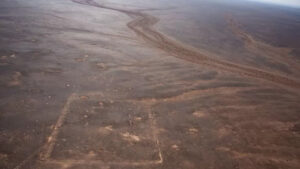 OXFORD, ENGLAND—By using open-source satellite imagery including Google Earth, archaeologists have discovered three previously unknown Roman temporary military camps along the border between Jordan and Saudi Arabia. According to a BBC News report, the researchers were able to identify the forts by their distinctive rectangular shape with entrances on opposite ends. “We are almost certain they were built by the Roman army,” says project leader Michael Fradley of the University of Oxford, who adds the enticing possibility that they may be evidence of previously undocumented military campaign in the region related the absorption of the Nabataean Kingdom into the Roman Empire in A.D. 106. It is extremely rare to find temporary camps in the region and these may have belonged to one or more cohort of camel-mounted troops.
OXFORD, ENGLAND—By using open-source satellite imagery including Google Earth, archaeologists have discovered three previously unknown Roman temporary military camps along the border between Jordan and Saudi Arabia. According to a BBC News report, the researchers were able to identify the forts by their distinctive rectangular shape with entrances on opposite ends. “We are almost certain they were built by the Roman army,” says project leader Michael Fradley of the University of Oxford, who adds the enticing possibility that they may be evidence of previously undocumented military campaign in the region related the absorption of the Nabataean Kingdom into the Roman Empire in A.D. 106. It is extremely rare to find temporary camps in the region and these may have belonged to one or more cohort of camel-mounted troops.
Burial of Roman Physician Excavated in Hungary
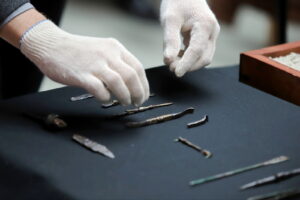 BUDAPEST, HUNGARY—Telex reports that archaeologists unearthed the first-century A.D. tomb of a Roman physician in a central Hungarian necropolis. He was buried during the period when the Roman imperial province of Pannonia was being formed. Placed at the feet of the man, who died between the ages of 50 and 60, were two wooden boxes containing medical instruments, including needles, pincers, and silver-plated copper alloy scalpels that were fitted with interchangeable steel blades. A muller found near the man’s knee was likely used to mix herbs and other medicinal substances. Eötvös Loránd University archaeologist Levente Samu said that the high-quality equipment would have been suitable for performing complex medical procedures. The team is planning to conduct isotope analysis and DNA testing to determine the doctor’s place of origin
BUDAPEST, HUNGARY—Telex reports that archaeologists unearthed the first-century A.D. tomb of a Roman physician in a central Hungarian necropolis. He was buried during the period when the Roman imperial province of Pannonia was being formed. Placed at the feet of the man, who died between the ages of 50 and 60, were two wooden boxes containing medical instruments, including needles, pincers, and silver-plated copper alloy scalpels that were fitted with interchangeable steel blades. A muller found near the man’s knee was likely used to mix herbs and other medicinal substances. Eötvös Loránd University archaeologist Levente Samu said that the high-quality equipment would have been suitable for performing complex medical procedures. The team is planning to conduct isotope analysis and DNA testing to determine the doctor’s place of origin

